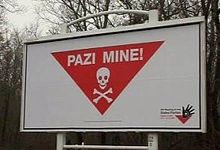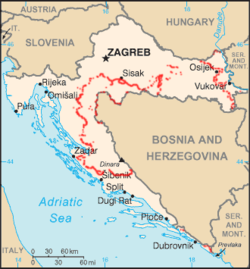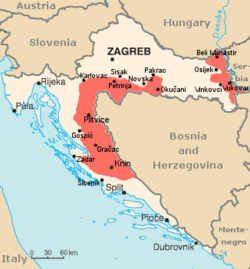- Minefields in Croatia
-
Minefields in Croatia can still be found along the former front lines of the Croatian War of Independence. During the 1991-1995 war, up to two million land mines were laid by both sides in the conflict. This has given Croatia one of the worst mine problems in Europe; several hundred people have been killed by them and it is estimated that the country will not be free of mines until at least 2019.
Contents
Mines in military strategy
Land mines were extensively used throughout the former Yugoslavia during the 1990s. In Croatia, they were a particularly important component of the military strategy of the Yugoslav People's Army (JNA) and, later, the Military of Serbian Krajina (VSK). The Serb-held areas of Croatia had a lengthy front line but little strategic depth - in some places the rebel Republic of Serbian Krajina was only 50 kilometers wide - and the VSK had a severe shortage of soldiers to defend the lines. The VSK was reliant on its superior artillery to repel attacks and buy time for reinforcements to be brought into play. Consequently it used extensive belts of mines, backed by trenches and bunkers, to deter and slow down infantry assaults so that artillery could be brought to bear on the attackers. A similar strategy was used by the Bosnian Serb Army for very similar reasons.[1]
The Croatian Army also used mines, particularly at the start of the war in 1991 when it sought to slow the Serbian/Yugoslav advance in the east of the country. However, it seems to have had far fewer mines in its arsenal than the Yugoslav and Serbian forces. Croatia retained no indigenous mine-production capabilities after the breakup of Yugoslavia[2] and was largely reliant on stockpiles captured from JNA barracks in government-held areas of the country.
Croatia ratified the Convention on the Prohibition of the Use, Stockpiling, Production and Transfer of Anti-Personnel Mines and on their Destruction in 1998,[3] and hosted the 6th annual meeting of party states in 2005.[4]
Locations of minefields
Mines were laid along almost the full length of the front lines, most notably in eastern Slavonia (especially around Vukovar and Osijek), western Slavonia and along the confrontation line in the Croatian Krajina region and parts of northern Dalmatia. Mines were also laid around the international border between the Serb-held Croatian Krajina and the Bosnian Army-held Bihać region of Bosnia and Herzegovina. Some smaller minefields were laid in southern Dalmatia around Dubrovnik and in the Konavle region, which was occupied by the JNA during late 1991 - early 1992.
In all, it was estimated that almost 8 percent of Croatian territory was affected by mines and between 1.5 million - 2 million mines were believed to have been laid during the course of the war.
Casualties
Between 1991 and April 2006, 430 people were killed by mines in Croatia and another 1,349 were wounded. The casualty rate has fallen in recent years as minefields have been mapped and put out of bounds. In 2005, four people were killed and nine wounded, but there had been no new casualties by the start of April 2006.[5]
A significant number of the victims have been children living near the mined areas. In response, the Croatian government has undertaken a major campaign of mine education and plans have been outlined to build playgrounds near mined areas, to encourage children to play there rather than on dangerous ground.
Demining operations
The Croatian government has dedicated itself to eradicating landmines (demining) as well as allowing and assisting a network of international mine clearance programs. It has spent substantial amounts of money on demining work, $24.9 million in 1999 alone.[2]
These efforts have resulted in significant areas being cleared of mines. In 2001, 42.3 million square meters of land were returned to productive use. By early 2004, the government declared its first mine-impacted county "mine-safe". The Croatian government plans to add two or three more counties to the mine-safe list by the end of 2006.
However, the government does not expect to be able to declare the country 'mine-safe' until at least 2009. In April 2006, the Croatian Mine Action Centre announced that 1,147 square kilometers are still categorized as being suspected of containing landmines, comprising twelve (of 21) counties; 30 percent of that area is known for a fact to be mined. One fourth of the entire population lives in these areas.[5] A significant complicating factor is the relatively undisciplined way in which mines were often laid, as well as the terrain in some areas. In the marshy ground of Eastern Slavonia, for instance, mines have been displaced or washed away by floods. As of October 2011[update], 48 deminers have been killed in mine clearance tasks since the end of the war.[6]
Clearance of landmines is carried out by several different organizations and commercial companies who compete through a competitive bidding process for the job. Adopt-A-Minefield (AAM) has supported mine clearance in Croatia since 1999 (working through the International Trust Fund for Demining and Mine Victims Assistance). All Adopt-A-Minefield donations earmarked for Croatia are matched dollar for dollar by the ITF.
The Croatian government has also been a strong supporter of the Ottawa Treaty banning landmines, which it signed in 1997 and ratified in 1998.[7] It has, however, been criticised for slowness in destroying its own stockpiles of mines and for retaining an unusually high number of mines for "training purposes".[2]
Mines and Tourism
The minefields issue has posed a serious image problem for the tourism industry in Croatia, even though no foreign tourists have fallen victims to mines in the country. In 2003 however, a Dutch tourist lost a leg as he stepped on a mine in an area close to a former army base on the island Vis. Even though this area has been cleaned (again) since, it is still considered a risk area for mines. Most tourist guidebooks to Croatia include warnings of the danger of mines and cite areas of particular concern, such as in eastern Slavonia.[8] The presence of mines in high-profile tourist areas such as the Plitvice Lakes municipality caused significant damage to local tourism and such areas have been made a high priority for demining operations. In the case of the Plitvice Lakes national park, for instance, the area was certified mine-free as early as 1998, enabling UNESCO to remove the park from its endangered list.
The problem of dealing with landmines has led to some tension between the tourism industry and the deminers. Zdenko Mičić, Croatia's minister of tourism, has vowed to remove mine warning billboards currently placed even on places (like ports) where there are no mines [9] before the 2006 summer tourist season. Such billboards are often displayed far from actual minefields as a means of raising public awareness of the problem. However, Mičić said that despite humanitarian nature of the campaign it is counterproductive for the tourist industry and that billboards should be removed.[10]
Mine-cleared areas
Select dates of mine-cleared municipalities are as follows:
References
- ^ Balkan Battlegrounds, p. 272 (Central Intelligence Agency, 2002)
- ^ a b c "Europe and the Ottawa Treaty", Paul Chamberlain and David Long, in Landmines and Human Security: International Politics and War's Hidden Legacy, ed. Richard A Matthew, Bryan McDonald, Kenneth R Rutherford, James N Rosenau; p. 90. (SUNY Press, 2004)
- ^ http://treaties.un.org/Pages/ViewDetails.aspx?src=TREATY&mtdsg_no=XXVI-5&chapter=26&lang=en
- ^ http://www.icbl.org/index.php/icbl/Treaty/MBT/Annual-Meetings/6MSP
- ^ a b "Many areas of Croatia still infested with mines", HINA news agency, 4 April 2006
- ^ "Kvadrat čišćenja mina tri kune, a kvadrat košnje trave sedam kuna" (in Croatian). Večernji list. 17 October 2011. http://www.vecernji.hr/vijesti/kvadrat-ciscenja-mina-tri-kune-a-kvadrat-kosnje-trave-sedam-kuna-clanak-336900. Retrieved 17 October 2011.
- ^ States Parties to the Ottawa Treaty
- ^ BOUSFIELD, Jonathan (2000): The Rough Guide to Croatia. Rough Guides Ltd. London. Page 43.
- ^ Report of 27 February 2006
- ^ MMPI
- ^ a b Croatia: Municipalities of Župa Dubrovačka and Ston Free of Mines
Further reading
- International Campaign to Ban Landmines (April 1999). Landmine Monitor Report 1999: Toward a Mine-Free World. Human Rights Watch. ISBN 1-56432-231-9. OL12155904M. http://books.google.com/books?id=hiwJHi8Pa2IC.
- (PDF) Landmine Monitor Report 2010. ISBN 978-0-9738955-7-5. http://reliefweb.int/sites/reliefweb.int/files/resources/0FB4E4B271CAB366C12577E50036FE99-ICBL_Landmine_Monitor_2010.pdf.
External links
Categories:- Minefields
- Croatian War of Independence
- Environment of Croatia
Wikimedia Foundation. 2010.



